Lecture IV
Dornach, 15th November, 1916
Continuing our
studies on the great works of Art, we will show some further slides
today, supplementing those that were shown last week. Today I
propose in the main to supplement what I endeavoured to explain
last week, of the connections and contrasts between the
Mid-European, or Northern, and the Southern Art. I tried to show
how the specifically artistic quality is always influenced by the
character of the South or of the North, while, on the other hand,
there were continual interpenetrations of the Southern and
Mid-European impulses, layer upon layer, as it were, so that it is
by no means easy now to see how these things really worked
together. Spiritual scientific investigations will in course of
time have to bring more and more light into these matters.
Today I wish to draw
attention to the contrasts from certain other points of view. You
will remember what I emphasised last time. From underlying impulses
of the Mid-European spiritual life, there arose what we may call
the art of expression — expression of Will and Intelligence
— the power to express the ever-mobile life of the soul. The
soul in movement — that is the goal of the Mid-European
impulse; while the Southern (which was, however, influenced at a
very early stage by the Mid-European) looks more to all that enters
our perceptions from the Divine-spiritual in the Cosmos, which
finds expression in the power of composition, and in features which
transcend the human.
It is a
characteristic abuse of our time to consider Art — even the
plastic Arts — far too much from the mere point of view of
the narrative and subject matter, while appreciating far too little
the specifically artistic qualities. At the same time there is
another equally pernicious error. Art is very frequently severed
nowadays from the general life of culture and civilisation, and
treated as though it were something that lives a life apart. This,
too, is wrong. For we need only have a feeling for the specifically
artistic qualities, for all that works in form and colouring, in
composition and the like — we need only wean ourselves of the
tendency to explain everything symbolically, or in other artificial
ways; we need but feel — before such pictures as Dürer's
‘St. Jerome,’ or ‘Melancholia,’ for
example, — how infinitely deeper is the mysterious ebb and
flow of the masses of light themselves, than any artificial
symbolism we may choose to read into these pictures. Then we shall
recognise that the specifically artistic qualities that come to
expression in the great works of Art, are also living in the whole
general life of civilisation. Out of the common feeling of his time
the artist works into the spheres of form and color and expression.
The time itself works through the soul of the artist. The whole
culture of the age finds expression in the characteristic works of
Art.
We saw last time how
the Mid-European, or Northern element, works its way upwards more
or less independently, while at the same time it grows together
with all that is brought to it through the Church — through
Christianity from the side of Rome. Until the 12th and 13th
centuries we witness the development of a unique artistic life in
Middle Europe, uniting the more Roman or Latin elements with a
strongly individual characterisation of all that is life and
movement in the human soul. We cannot understand what took place
until the 12th and 13th centuries if we merely consider what we
know of the spread of Christianity in the succeeding time. For the
whole spread of Christianity was a very different thing in those
earlier centuries from what it afterwards became. It was only in
later times that the rigidly dogmatic qualities which so repel us,
came into prominence, though, needless to say, there were all
manner of excesses even before the twelfth century. And while in
Middle Europe the systemmatising, formal tendency of Rome was
always felt like a foreign body, still the Christian impulses found
their way most wonderfully into the soul-life of the people —
especially into the more subconscious, feeling elements of the
soul.
This entry of
Christianity into the soul found expression especially in the
sphere of Art, where there was a wrestling for plastic power of
expression.
Here we may point to
a truth which can be characterised in two very simple statements
which are, none the less, very far-reaching. We may ask this
question: To what does Art appeal among the Southern peoples? To
what did it appeal already in antiquity? And elsewhere in the
South, in the period of its decline and in its resurrection from
the early to the late Renaissance? To what does Art appeal in the
more southern regions? It appeals to the fancy and imagination.
This statement is of infinite importance. The appeal is to the life
of the fancy and the imagination, which is present in the souls of
the southern people with a slight, suggestion of a sanguine
temperament in these respects. Thus in the southern regions we see
the Christian ideas entering, above all, into the imaginative life,
and borne by fancy into the realm of Art.
Needless to say, such
a statement must not be pressed too far. I would say, the statement
itself should be artistically understood.
Only so, my dear
friends, could it come about that in the time of the Renaissance
artistic fancy rose to such great heights of creation, while the
moral life, as we showed in a recent lecture, fell to the state
revealed in the attacks of Francis of Assisi, and later of
Savonarola. The situation stands before us when we contrast the
fiery attacks of Savonarola which were all in vain, with the
infinitely rich life of Christian vision and imagination in the
plastic works of Donatello, Michelangelo, Raphael, Leonardo and
many others.
Art in the North
speaks differently and appeals to a different element of soul,
namely, to mind and feeling. Once more, these things must not be
pressed; nevertheless, in such a statement guiding lines are given
for the understanding of whole epochs of History. However we may
believe that Christianity contains a peculiar, morally religious
impulse of the soul, this impulse did not find its way into the
element of fancy and imagination in the Southern culture which
reached such giddy heights in the Renaissance. But in the North,
the centuries until the 12th — nay, the beginning of the
13th — reveal in Art the progressive appeal of Christianity, and
especially the tragic elements of Christianity, to human heart and
feeling. The Art of the Italian Renaissance strives to make the
countenance of Christianity itself as fair as possible — that,
after all, is the essential element in the Renaissance Art: But the
centuries to which I now refer, in Middle Europe, are all devoted
to the striving to realise the Story of the Passion — with all
its tragedy and drama, until the tragic story becomes their very
own in heart and soul.
Down to the
Carolingian period in Middle Europe, Mid-European paganism
continually breaks through into the life of feeling. But in the
centuries from that time onward until the 12th and 13th there
arises out of the very soul of Middle Europe an inherently
Christian Feeling for all human life. And the strange thing is that
from the 13th century onward a certain decline can be observed.
Yet, as I explained last time, even now when another element once
more overwhelms it, there is still the constant striving for the
Mid-European soul to assimilate into its deepest inner life all
things that come to it, so that, after all, there is a continuity
of work and progress in the best souls, from the 11th century on
into the 15th and 16th.
The gradual entry of
Christianity into the life of the people is also recognisable, or,
rather, would be recognisable, if the dramatic representations
which did, indeed, grow more and more significant toward the 13th
century, had been preserved. All that we now bring to light
again — the Christmas and Easter Plays, and Plays of the Three
Wise Men — are of a later date, and are but a faint reflection
of those earlier ones which tended to a more universal presentation
of the Christian world-conception. The Play concerning Anti-Christ,
of the 12th century, which has been found at Tegernsee in Bavaria,
and a later Play on the Ten Virgins, these, too, are but echoes of
Plays that were presented everywhere, dramatising the Biblical
stories and the sacred legends. Out of this life with the Christian
world-conception as a whole, there arose the works of Art which we
shall see again today and which we say last time. There followed
what I might call a slow and silent working towards the deepening
of the soul's life and its artistic power of expression. It finds
expression wonderfully in Dürer's representations of the
Passion, and notably in the head of Christ Himself as conceived by
Dürer and others. It will be a satisfaction to me if we can
show these pictures, too, on some future occasion; we do not
possess them at present.
If we study the
progress of artistic penetration in pictures of the countenance of
Christ till Dürer's time, and in other things as well, we find
there was really attained in Mid-Europe at that time an astonishing
degree of maturity. It lies inherent in the subtle difference
between the Mid-European and Northern, and the Southern life, which
developed, as it were, the last phases of the Fourth Post-Atlantean
epoch — (albeit the Fifth epoch already shone into the
Renaissance); — the South in its deepest tendencies of
feeling was still expressing the last phases of the Fourth; while
in Mid-Europe and the North the Fifth Post-Atlantean epoch was
preparing. What afterwards became the expression of the individual,
and of all that is mobile in the human soul — the soul in
movement and emotion — all this was working its way up from
unconscious depths.
Here we see the whole
life of the two regions in their essential difference. We need only
bear in mind how much in the Southern Art is due to the fact that
there still existed a living atavistic perception of what plays
from spiritual regions into the realms of sense. For this was,
indeed, preserved in what are known to us of the Byzantine forms of
Art — in all the suggestive forms and figures that have come
down to us. Take, for instance, what works upon us with such
suggestive power in the Art of the Mosaics, and in all that is
connected with the name of Cimabue. Here it is more the Christ
Figure that works upon us. In Middle Europe it is, rather, the life
of Jesus that is presented to us, for the artistic forms are
created directly out of the inner life of the soul.
Superhuman
as is the Byzantine type of Christ, inwardly human is the
Christ type which was afterwards worked out by Dürer.
The Fourth
Post-Atlantean epoch, including the latest flower (in the Italian
Renaissance) has essentially the quality of looking upward to the
superhuman and typical; the superhuman and generic nature
of the soul, setting aside the individually human. The Southern
peoples brought to their Art, in a far higher degree, the ancient,
the generic nature of the soul in its superhuman and divine
quality.
In the Northern Art,
on the other hand, we see the strong decided striving of the
individual, as it works its way upwards out of every single human
soul. The more these things are understood, the more this will be
confirmed.
The southern life
still contains mankind as a whole. Think how intensely an Athenian
was an Athenian, or a Spartan a Spartan, so that Aristotle rightly
called man a “Zoon politicos” — a political animal.
The “political animal” was developed to its greatest
height in Rome, where, we might say, man lived more in the streets
than in his own house; and with his soul-life, also, he lived more
in the life that surrounded him than in the house of his own soul.
Such, truly, was the Southern imagination as it worked in the world
of space. From the very outset men live together, live together as
a whole, and the life of Art itself arises out of this principle.
This is a feature common to all the Southern Art. They decorate the
churches and the public squares; everywhere we see how they reckon
with the fact that the people run gladly together, crowd gladly
into the churches, or in the public squares, drawn thither by their
very temperament and expecting what will there be set before them.
To possess themselves fully, they need this life in the outer
world, this living with the group-soul nature — with all that
is most eminently political — in the right sense of the
word.
All this is different
in Middle Europe. In Middle Europe man lives within himself; seeks
his experiences in his own house and home, even the house of his
soul. And if he is to dedicate himself to the group-nature, his
heart must first be conquered for it, he must in some way be
summoned to it. Many of the underlying impulses of Gothic
architecture will be found to lie in this direction. The buildings
erected by Gothic architecture stand there not because the people
are already running together of their own accord, but, on the
contrary, because they must first call the people, bring them
together, as it were, through mysterious and suggestive influences.
This is expressed in the very forms of the Gothic. The individuals
must first be called to the group-life. And the same thing
lies inherent in the whole treatment of light and darkness which I
described to you the other day. In the elemental surging and
interweaving of the light into the darkness, man finds an element
into which he can enter to free himself from his own separate
existence; albeit he can carry his individual existence, his
individuality with him into this very element, because it is so
akin to the nature of the soul.
In all these things
we find the distinguishing feature of the Northern as against the
Southern Art. Hence the striving — the successful striving
— of the Northern Art to express inwardness of life and soul.
We need only call to mind the portraits, the Madonnas, for
instance, of Van Eyck. These Madonnas — their facial
expression altogether determined by a turning inward of the life of
the human soul — this speaking from an inwardness of soul in
the countenance and gesture — all this, Raphael would never
have painted. Raphael raises what he paints beyond the human; Van
Eyck lifts it into the still more deeply human, so as to seize the
human emotions with his paintings, the human hearts of those who
see them. Once more it is a question of grasping the human soul.
The priesthood until
the 12th and 13th centuries were well aware of these possibilities
of the human soul in Europe. They reckoned with these things. They
worked with the heart and mind of the people. And without a doubt,
much that arose out of this wrestling for artistic powers of
expression, came about through the co-operation of the religious
orders with that inner life and character of the people which we
have here described. We must by all means understand how these more
Northerly qualities of artistic creation are connected with the
protesting folk-soul of the North, rising up in opposition
against the Roman element.
Luther went to Rome.
But he saw nothing of the sublime heights of artistic creation; he
saw only the moral degradation there. And this implies very much.
No doubt he met one or another of the great painters of Rome on the
Square of St. Peter's, but what concern had they for him, these men
who created out of al altogether different mood of soul, something
to which he had no inner relationship. And yet, Luther's very
radical one-sidedness was in another way the product of the same
Mid-European characteristics which, if I may say so, wrestled most
sublimely in the realm of plastic, pictorial expression, and
attained an artistic height that stands, in a certain way, so
magnificently and independently side by side with the Art of the
Italian Renaissance. (We need make no comparisons, for they are
always trivial.)
We will therefore now
show a few more pictures, supplementing those we showed last week.
First we will show some wood-sculptures from the very beginning of
the 13th century. They are at Halberstadt.


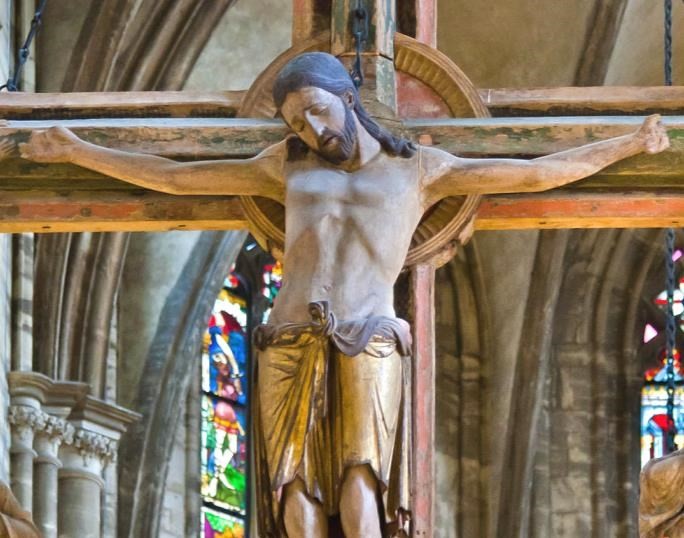

1. Crucifixion Group. (Cathedral. Halberstadt.)
Look at this
Crucifixion Group. I will only say one thing to characterise what
is most important. In this group you can see how deeply the story
of the Passion had found its way into their lives by that time.
There is Mary, there is St. John, and in the center the Christ,
looking down towards her. If you could see the face you would see
an infinite deepening of soul in the expression, an overwhelming
depth. In Mary, if you have a feeling for these things, you will
recognise at once the flowing together of the more Roman, priestly
conception with the Mid-European depth and tenderness of feeling.
Here it is recognisable in a most wonderful way. We shall presently
show the face of Mary in detail.
This group reveals
how they contrived, out of the specifically Mid-European creative
impulse of the soul, to mould the Christianity which had conquered
the Mid-European country. We will now show the detail.
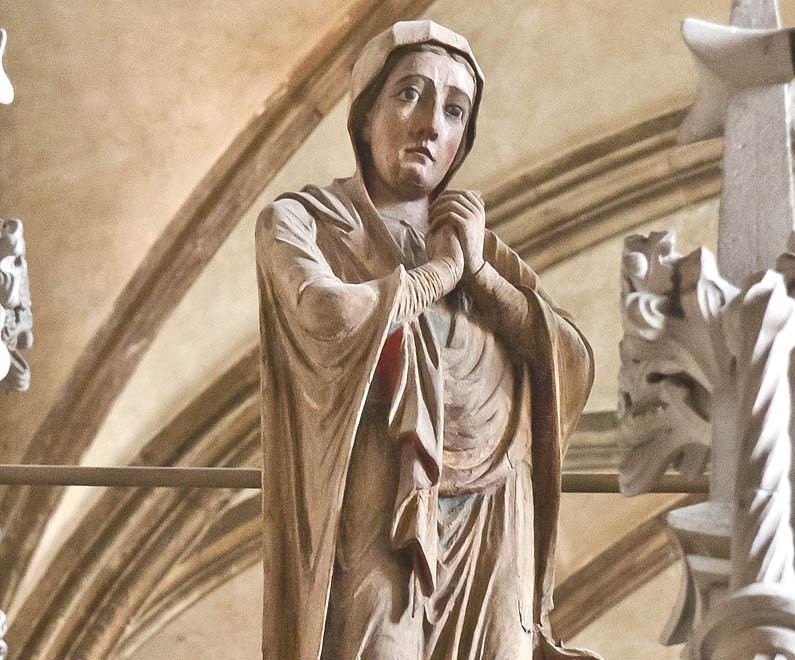
2. Head of Mary. (Detail of the above.)
Wonderfully
characteristic is the expression of the face. The expression in the
Southern Art is such that the eyes look far out into the world; in
the Northern Art the soul, as it were, presses forward into the
look of the eyes from within. Here the two are altogether
interwoven — united with one another. A tenderness of soul in
the expressions hovers gently, wonderfully, over a more Latin,
Roman rounding and perfection of the features.
These things must not
be pressed. But I beg of you to observe in all the following
pictures how very differently the clothing and drapery is treated
in the Mid-European Art and in the Southern. Undoubtedly, such
things must not be pressed too far; yet it is true to say that in
all the Southern Art the drapery rather surrounds and veils the
human form, follows the lines of the form closely, continuing, as
it were, the bodily forms. In the Mid-European Art the treatment of
the drapery is different. It proceeds from the emotion and movement
of the soul. According to the gesture of the hand and the whole
attitude of the figure, the quick, mobile life of soul is continued
into the raiment. The latter adheres less closely to the body. It
does not seek, as in the Southern Art, to veil or to express the
forms of the body. It is, rather, like a continuation of the living
experience of the soul. You will see this more and more distinctly
as we go on into the following centuries.
We have now come to
the famous:

3. Crucifixion Group. (at Wechselburg in Saxony.)
This, too, is in the
wood, and dates from the first third of the 13th century. None the
less, you will see in it a wonderful progression from the former
group whose subject is so similar. Observe the communion of soul
between the Mary and the Christ-Figure. See how the faith in the
Christian world-conception, deeply united with the human soul,
appears in the St. John and in the Mary-Figure, as the power that
overcomes all things. The Christian world-conception had entered
into the souls of these people so as to become an universal
historic conception of all earthly evolution. See how Adam, down
here, receives the Blood of the Redeemer dropping downward from the
Cross. Study the face of Adam, how he is touched by the influence
of Grace which he can now receive inasmuch as he may catch the
Blood of the Redeemer flowing from the Cross. You will realise with
what infinite depths Christianity had found its may into the lives
of these people. It had risen to a universal and truly
Cosmic conception.
Angels carry the
Cross. God the Father descends with the Dove, setting His seal upon
the fact that what He had given to the Earth in His Son gives, at
this moment, the whole Earth its meaning. In this group with all
its artistic perfection we see how deeply Christianity had found
its way into Middle Europe,because they tried again and again to
permeate it with the human heart and feeling, — to permeate
it from within the human soul.
On the other hand, in
the South, it was permeated by fancy and imagination, thus
producing that peculiar permeation, so free from the moral element
— (or shall we say, in order not to give offence, so free
from moral cant) — which comes to expression in the
Renaissance in the South.
If you were to make a
study of the progress in the representation of the Christ-Figure,
this Head of Christ would be an important station. Also the Head of
Christ in the Cathedral of Amiens, and afterwards, the Head of
Christ by Albrecht Dürer.

4a. (Cathedral of Freiburg in Saxony.)

(Cathedral of Amiens)

Head of Christ by Albrecht Dürer.
We now pass to some
sculptures which are found at Freiburg in Saxony, also dating from
the first third of the 13th century. They show an altogether
different aspect, though here, too, it is the sacred history, and a
deep striving for inwardness. It is not too much to say that one
loves to dwell on every single face. The next picture:
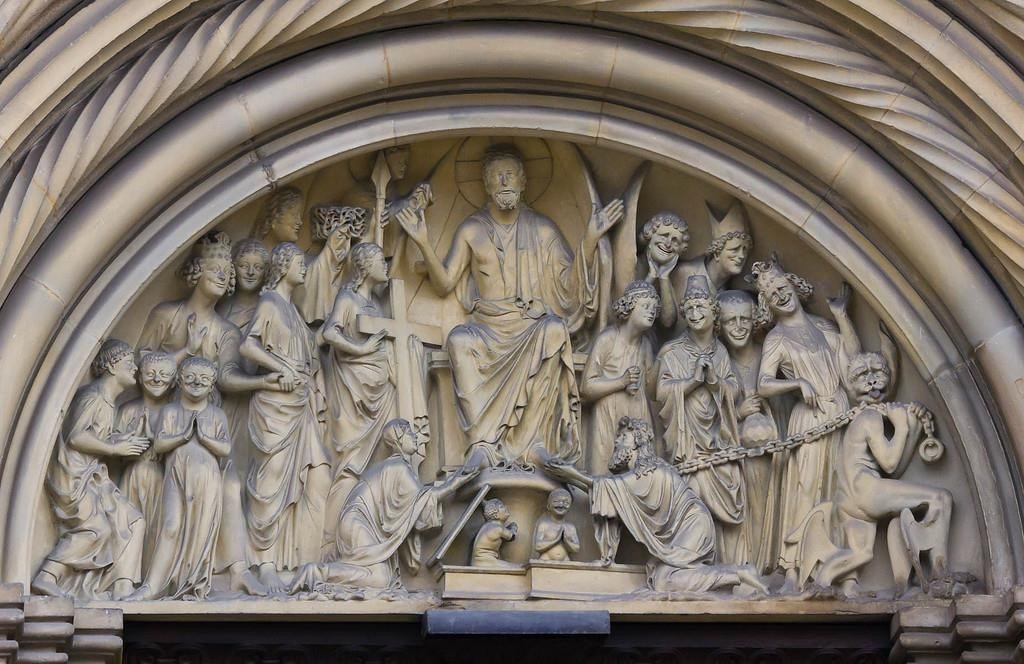
4b. From the Golden Gate, (Cathedral of Freiburg.
Saxony.)
shows us two figures.
The one, the figure of a woman, is hard to interpret. Perhaps she
is an “Ecclesia.” The other is said to be Aaron. These
things are not essential. The figures are undoubtedly connected,
allegorically or in some other way, with the Christian
world-conception. Once more, observe the deepening of the soul's
life. The contrast of expression between the face on the left, and
that on the right is particularly fascinating from this point of
view.

Two figures. (Cathedral of Freiburg. Saxony.)
Supplementing what we
showed last time of the Cathedrals at Naumburg and Strasburg, we
will now show some sculptures from the Cathedral at Bamberg. Here,
to begin with, we have two.

5. Figures of Prophets. (Cathedral at Bamberg.)
See how directly the
dramatic element, the living movement of soul, is expressed in the
attitudes, representing the interchange between one soul and
another. C. single moment is presented to us, while at the same
time the two contrasting characters are well expressed.

6. The Last Judgment. (Cathedral at Bamberg.)
The composition is by
no means great, but the expressiveness of soul is marvellous. He
must remember that this dates from about 1240. Spiritual scientific
research will in course of time be confirmed, in that it does not
suggest — as many people still do today — that the
Mid-European element, in its presentation of the Christian
world-conception, was in any high degree influenced by the
Southern. That, indeed, is not the case. On the contrary, the very
opposite is true.
The different streams
are not as yet clearly seen by external history. It is not seen,
for instance, what I pointed out the other day — how the
Northern impulses worked down even into the creations of Raphael
and Michelangelo. Artistically, this conception is altogether a
product of the Northern spirit.

7. The Emperor Heinrich, the Empress Kunigunde,
and St. Stephen. (Cathedral at Bamberg.)
This example shows
how the worldly and the religious elements played into one another.
This was, indeed, the case, especially at the time with which we
are now dealing. The worldly and the religious were brought
together in the effort which I characterised just now. The souls of
men had to be won over; the individual souls must first be called
— must by some means be gathered together, if they are to
look up in community, in congregation, to the spiritual world.
Likewise, they must first be called if they are to express reverence
in one way or another, for something in the outer worldly sphere.
Hence the worldly is
brought together with the ecclesiastical element. Here, then, we
see the Emperor Heinrich, the Empress Kunigunde, and, on the left,
St. Stephen.
Needless to say,
these things presuppose, as a rule, the naivete of the common
people, their blind devotion and dependence. Today, in the fond
belief of our contemporaries, these things are overcome. Inwardly,
they are present all the more. On the part of the great lords
themselves there is very frequently the underlying idea (not
unconnected with very human qualities, which shall be nameless),
that they themselves stand just a little nearer to the various
Saints and supersensible powers than ordinary mortals do.
We will now show a detail, the middle figure of this picture.

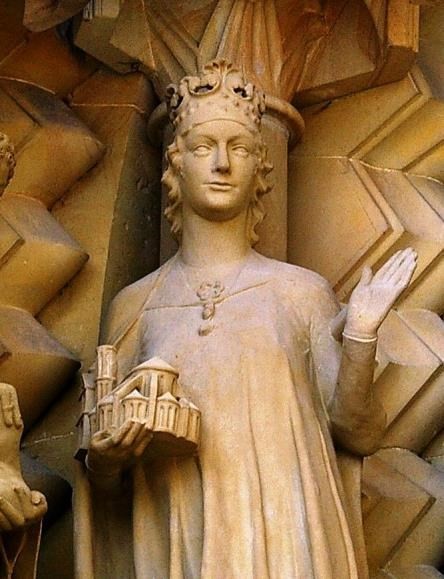
8 . The Empress Kunigunde. (Detail of above.)

9. St. Peter, Adam and Eve. (Cathedral at Bamberg.)
The Old and the New
Testament were always conceived in unison, as the promise and the
fulfilment. Follow the detail of these figures.
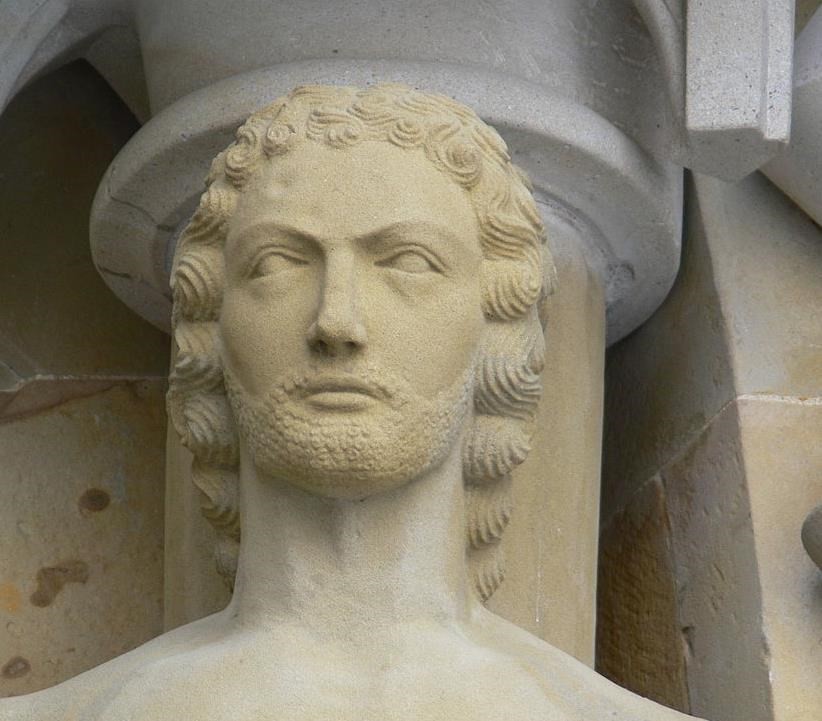
10. Adam. (Detail of above.)
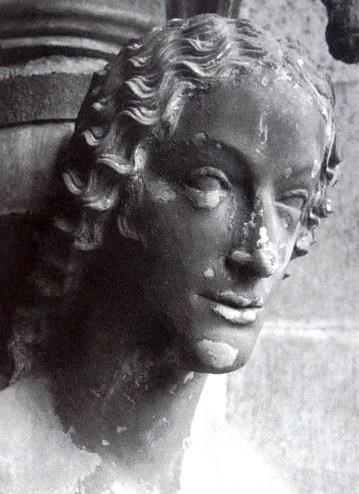

11. Eve. (Detail of above.)
And now another
figure from the same Cathedral.
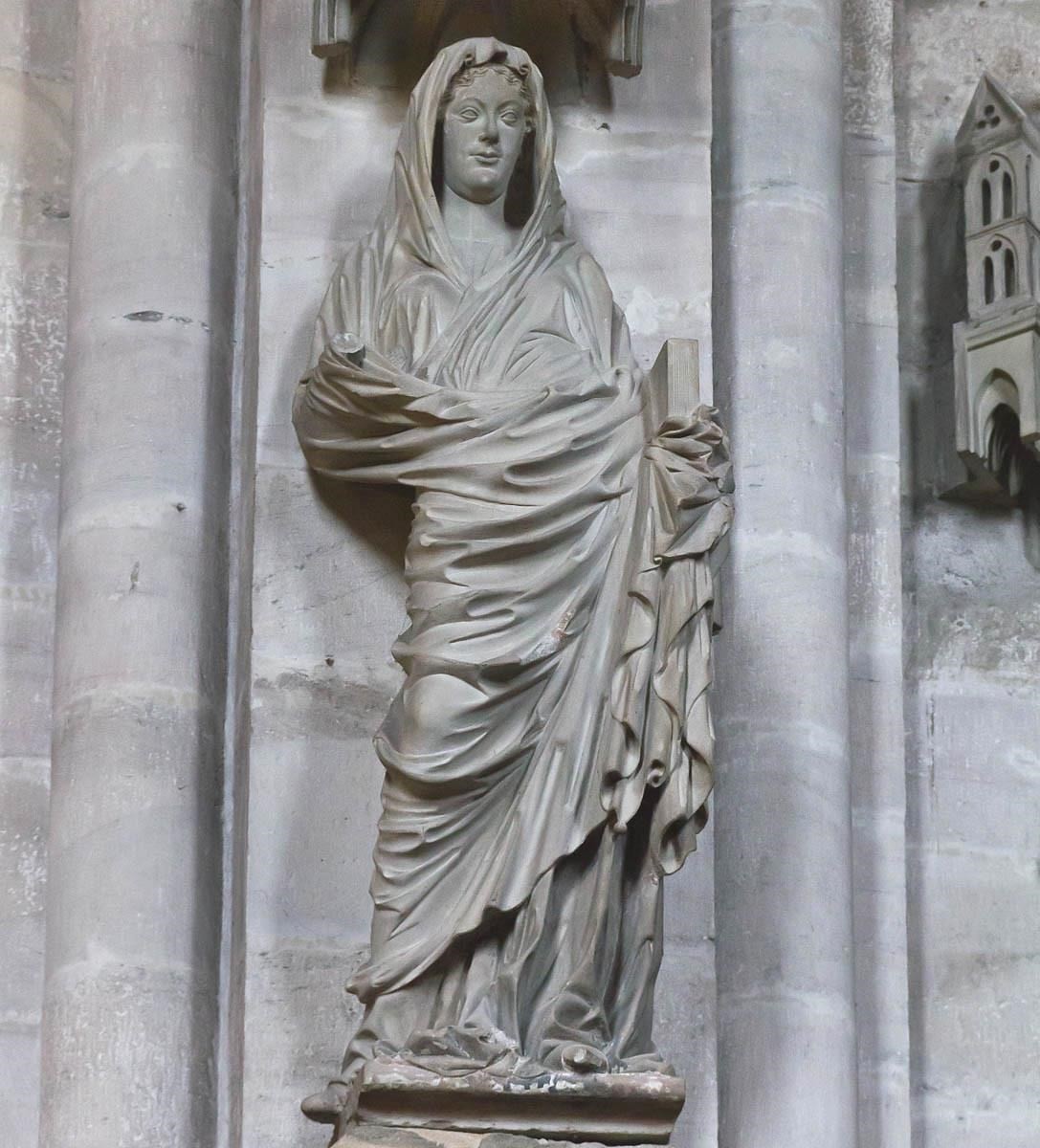
12. Mary. (Cathedral at Bamberg.)
A figure of Mary,
showing — from whatever point of view you may consider it
— how richly the qualities which I described before, come to
expression in this stream of Art. You must remember that this was
done about the year 1245. What would you look for in the South at
that time? The next Picture, from the Cathedral at Bamberg again,
represents the figure of:

13. The Church. (Cathedral at Bamberg.)
A favorite
representation at that time. Last time we saw the corresponding
figure from the Cathedral at Strasburg. The figure of the Church is
conceived with a certain inner freedom. Her soul is free, she gazes
freely far into the world, with wisdom.

14. Head of “the Church.” (Detail of
the above.)
This figure is in
contrast, as we saw last time, with the Synagogue, who is
represented once more with bound and downcast eyes. The whole
posture is intended to represent this contrast in every detail,
even to the sweep of the drapery.


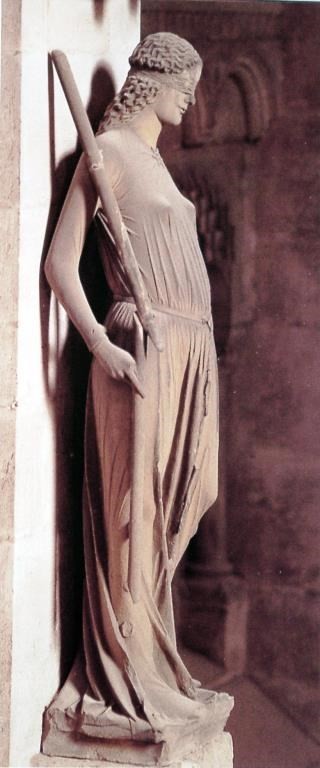
15. The Synagogue. (Cathedral at Bamberg.)
Look at the lower
portion of the dress, how well it is adapted to the movement of the
soul. We will insert the 'Church' once more, in order that you may
compare the draperies:

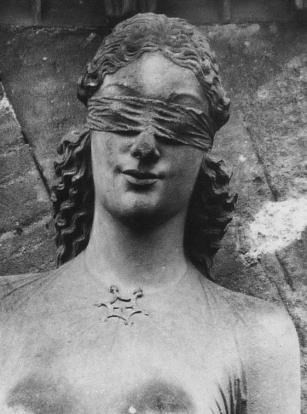
16. Head of the “Synagogue.” (Detail
of the above.)
And now a worldly, or
secular figure from the same Cathedral.
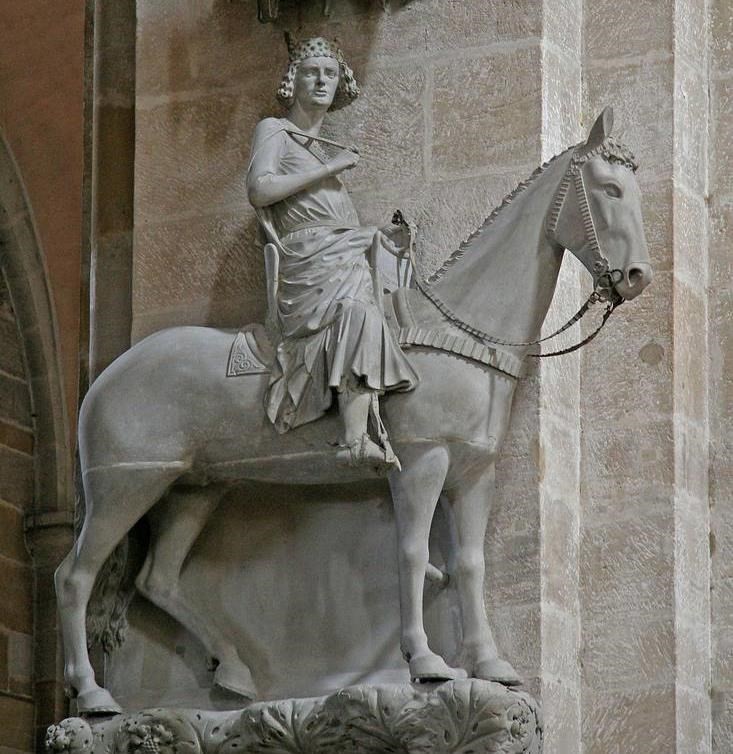
18. King Stephen. (Cathedral at Bamberg.)
Study the expression
well. The head, which we will now show in detail, is most
wonderful:
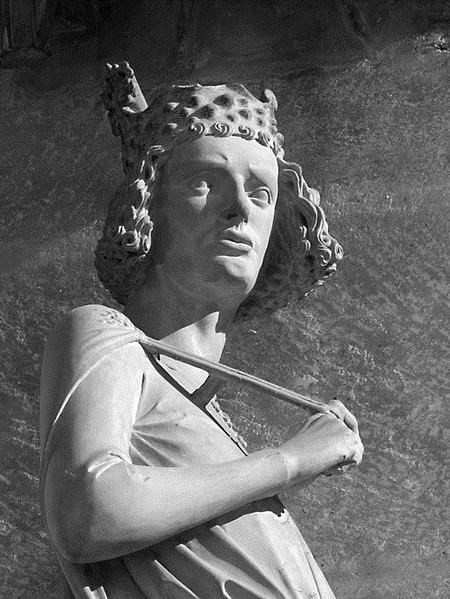
19. Head of King Stephen. (Detail of above.)
We now pass on to the
14th century, and see what had occurred by that time. We have a few
figures from the Cathedral at Cologne, first half of the 14th
century.


20. Mary. (Cathedral at Cologne.)
It is easy to see
that a certain decline had taken place. The next picture is also
from Cologne:


22. St. James and St. John. (Cologne Cathedral.)
Going further in the
14th century we now come to a figure of St. Paul by a master known
as the “Master of the Clay Figures.” These figures were
executed in burnt earthenware.
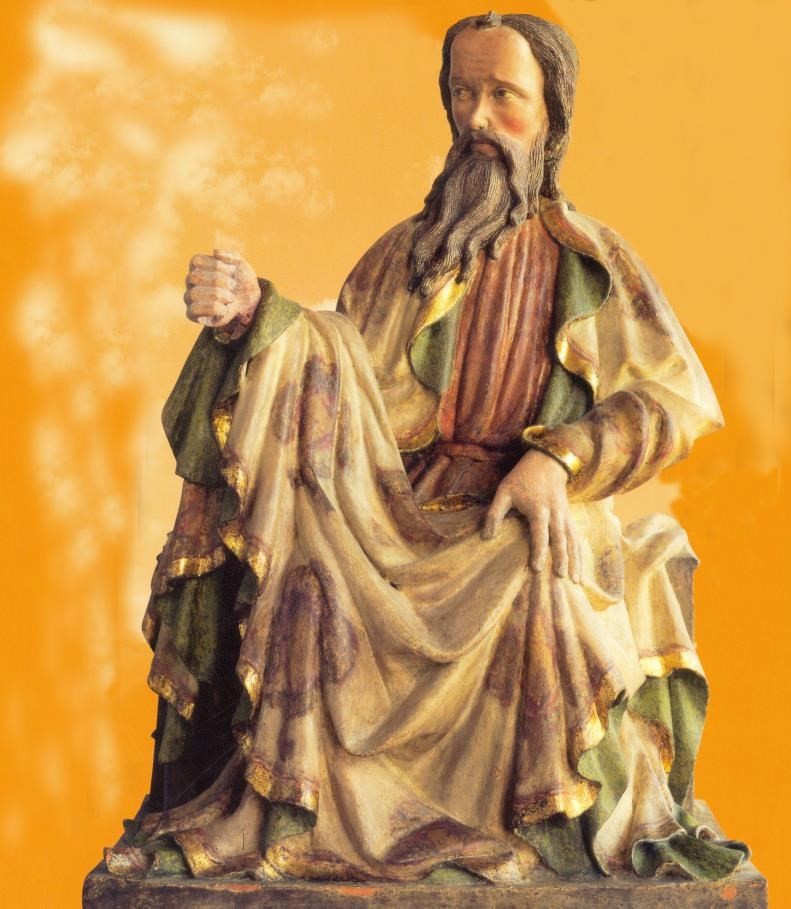
23. The Apostle Paul. Nuremberg.
Having now shown the
rise, and to some extent the decline of a stream of evolution
complete in itself, we will give a series of pictures from the
Chartreuse de Champmol at Dijon, which are really great of their
kind. Most, if not all of them are the independent work of the
Dutch sculptor, Sluter, or else done under his direction. He
brought to the Chartreuse at Dijon, from the Netherlands, an almost
unique power of individual characterisation. From many points of
view we see this individualising tendency in his work.
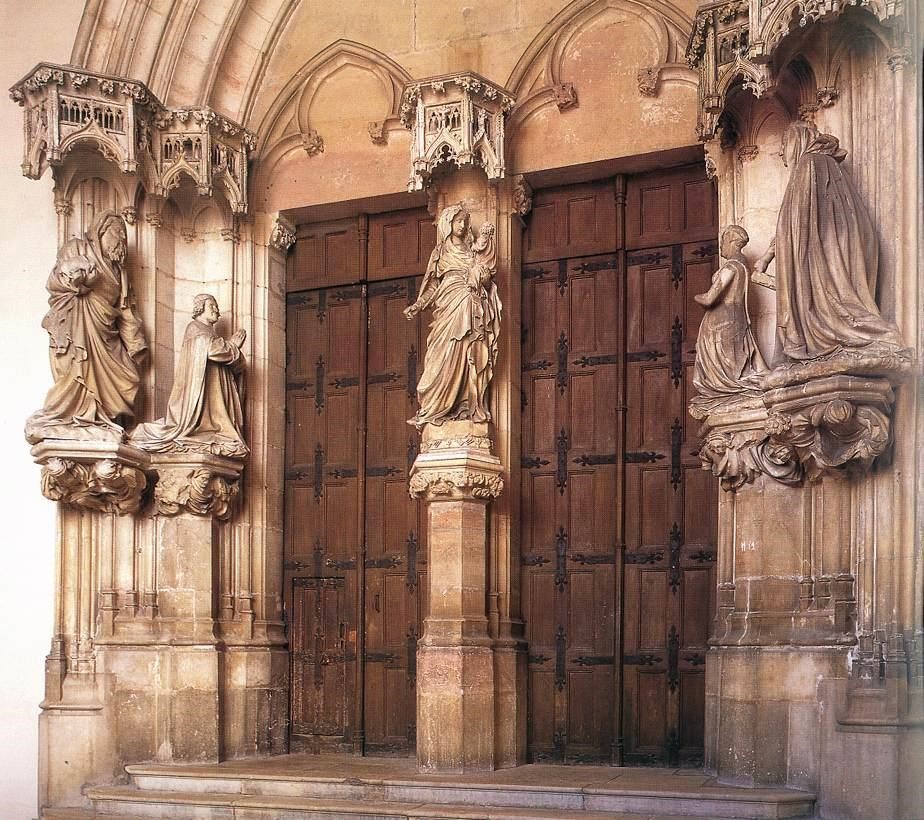
24. St. John the Baptist. Philip the Bold. The
Madonna.

25. The Madonna. (Dijon also.)

St. John the Baptist. Philip the Bold.
Here especially you
see the Art of individual characterisation. Compare this Madonna
and Child of Sluter's with the next picture (Moses) and realise the
power of one and the same man to characterise these two.

26. Moses. (Dijon.)
Remember that this
Chartreuse at Dijon was built in 1306 to 1334; it was therefore the
beginning of the 14th century. Compare this with Michelangelo's
Moses — for why should these things not be placed together
— they are, indeed, comparable.
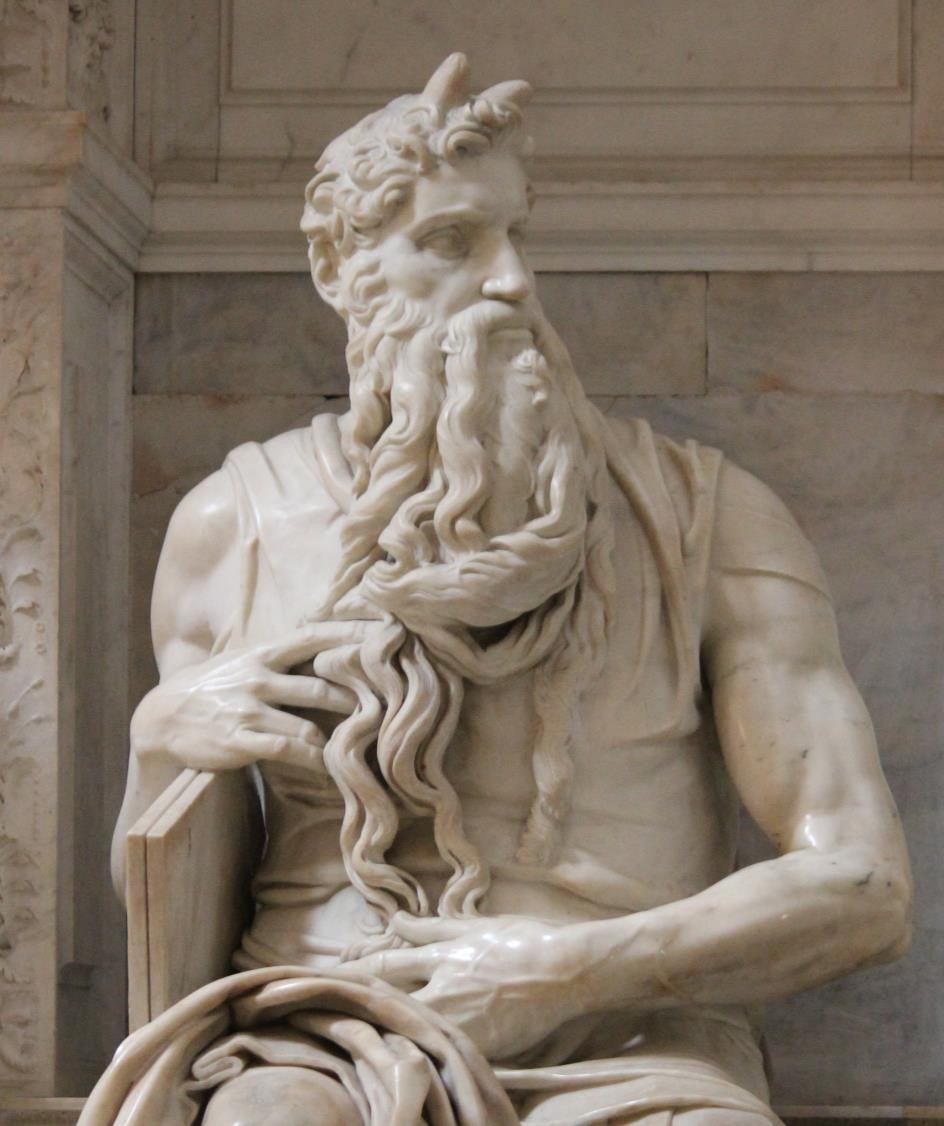
26.b. Moses. Michelangelo. Rome.
And now by the same
artist as before — Sluter.


27. Jeremiah. David. Zachariah. (Dijon.)

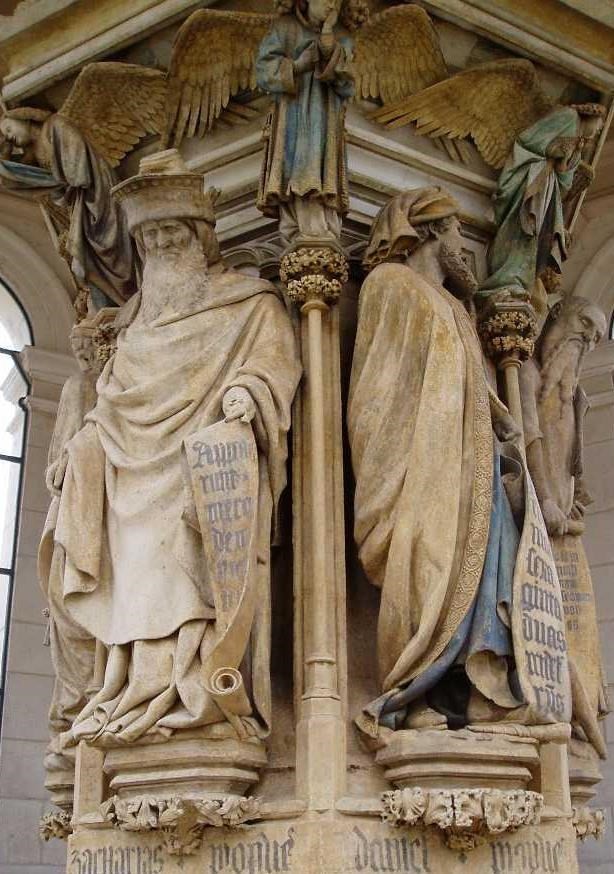
28. Zachariah. Daniel. Isaiah. (Dijon.)
To live with the
prophetic figures so as to achieve this degree of
individualisation, was, indeed, most wonderful. We will now show
one of the figures in detail:

29. Jeremiah. (Detail of above.)
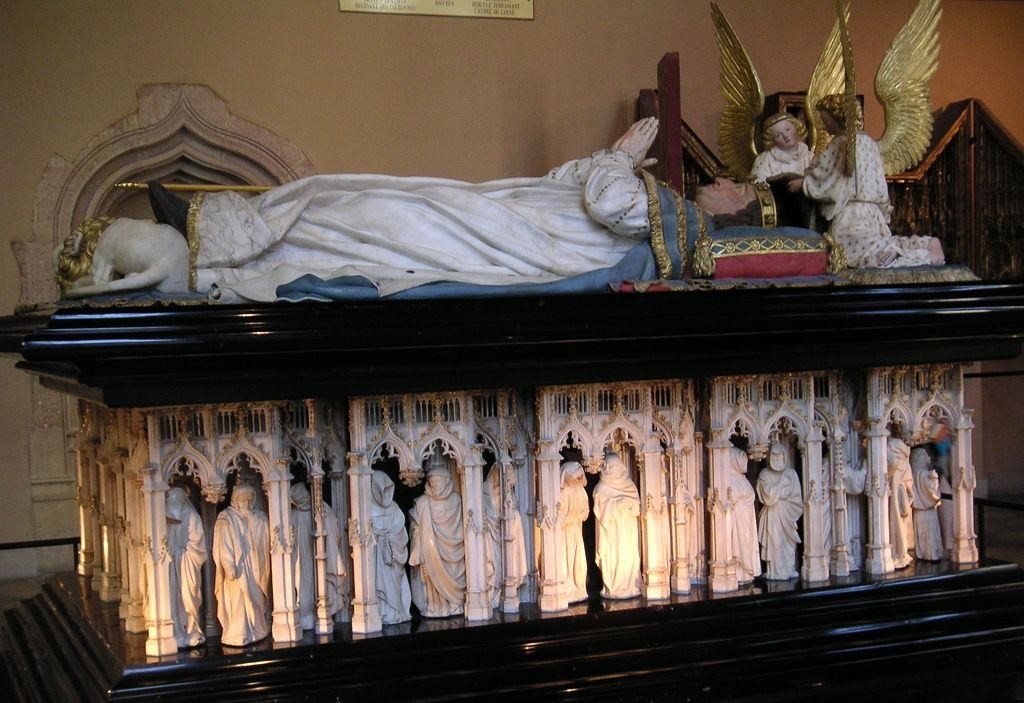
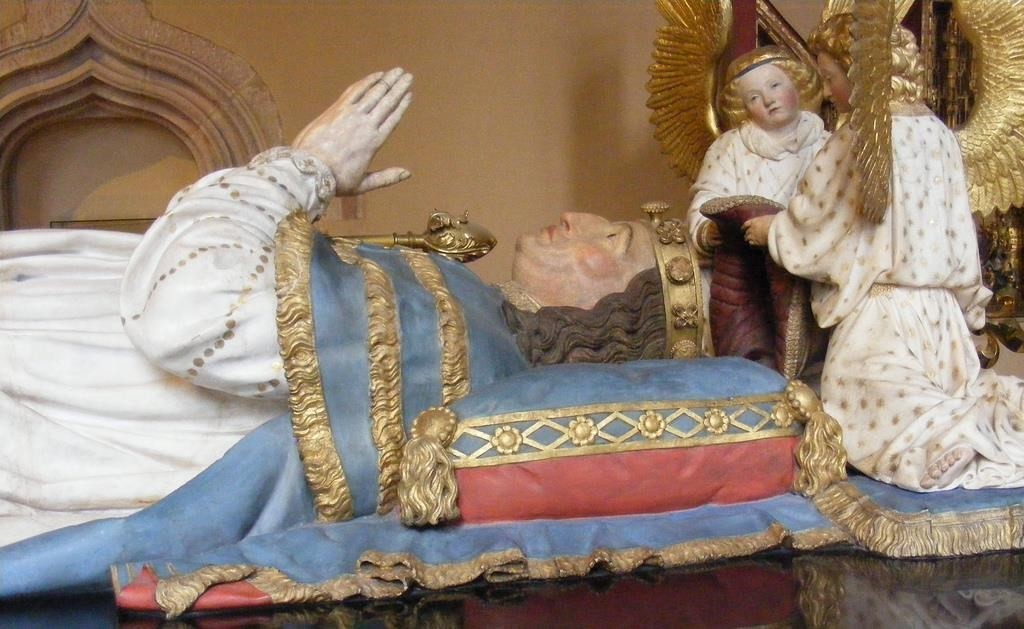
30. Tomb of Philip the Bold. (Dijon.)
These are by the same
artist. The age was especially great in the creation of tomb
monuments. We will show the detail of the upper part:


31. Upper portion of tomb, with two Angels.
(Detail.)
The figures round the
base of the tomb which were formerly so small, are wonderfully
executed when you come to see them in detail.

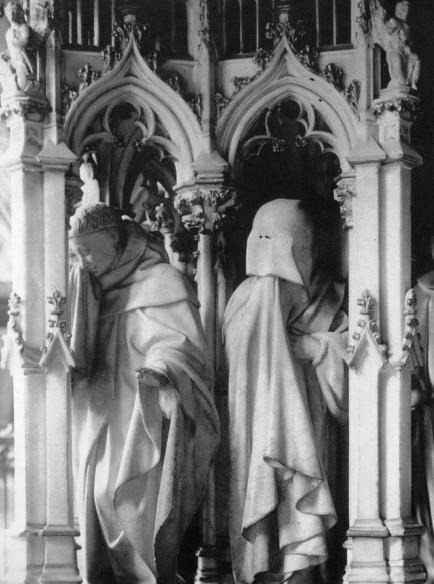

32. Figures of two monks. (Detail of above.)
Such is the
individual characterisation of all the single figures round the
base of the tomb. Here is another group.
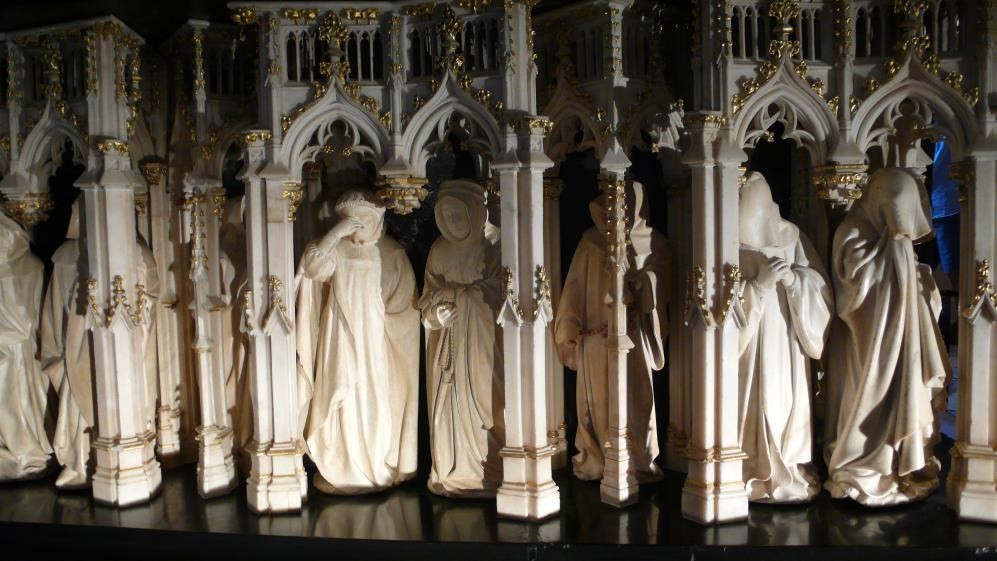

33. Group of Monks. (Tomb of Philip the Bold. Dijon.)
We now go on to an
artist of the 15th century. (We must go according to the pictures
we possess at the moment.) The last pictures, you remember, were by
an artist of the early 14th century. With the Cologne Master, and
the Master of the Clay Figures who made the group we saw before, we
came to the 14th century. We now pass on into the 15th. Here, then,
we have two figures by
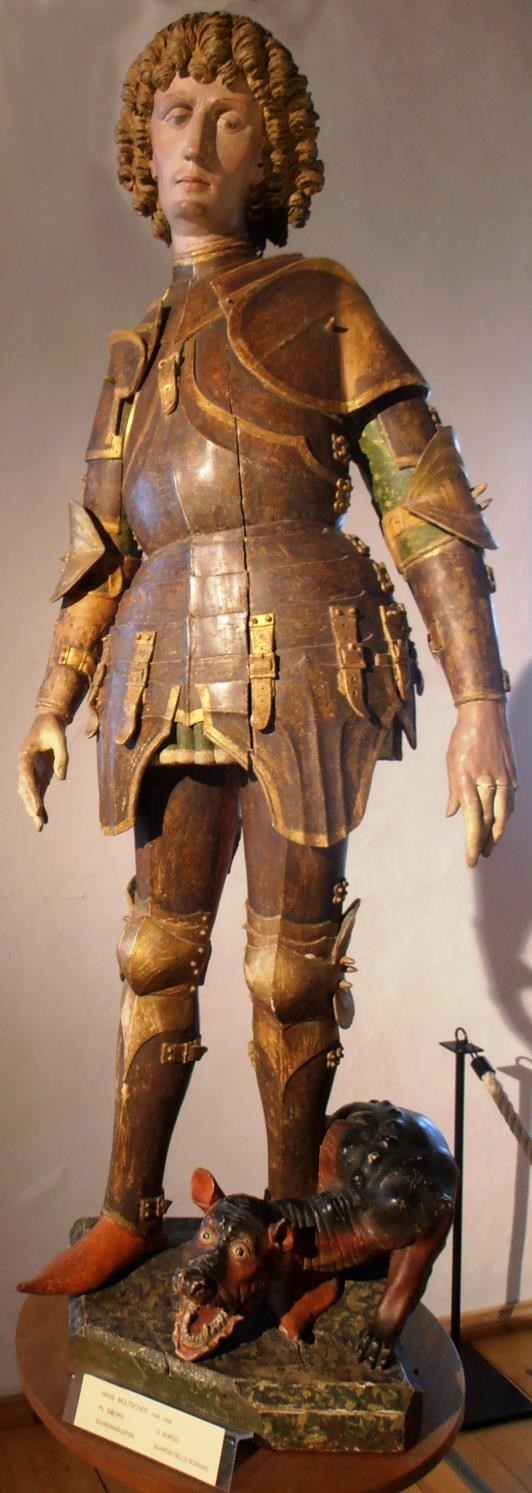

34. Multscher. St. George and Florian.
(Spitalkirche. Sterzing.)
This is about the
middle of the 15th century. The next is a Madonna, by the same
artist (Multscher).

35. Madonna. (Pfarrerkirche. Starzing.)
And now we go further
and further in what I described just now as the elaboration of the
Christian subjects with deep inwardness of soul. The following are
figures carved in wood, at Blutenburg (end of the 15th century).
The art of characterisation has, indeed, attained its ideal to a
marvellous extent.
The figure of Mary,
carved in wood — end of the 13th century:



36. St. Matthew. St. Mary. and St. John
(Klosterkirche. Blutenburg.)
This, then, is the
time when Michelangelo and Raphael were born. The next picture,
too, is from Blutenburg.

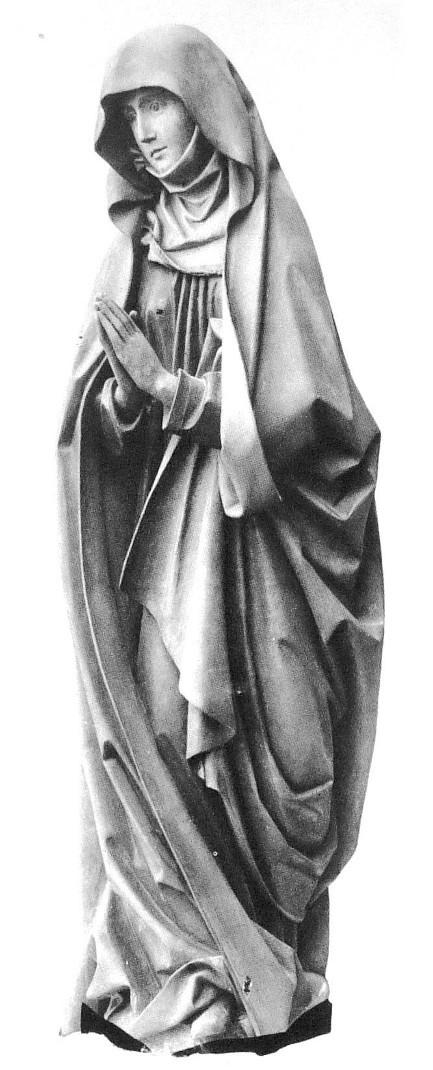
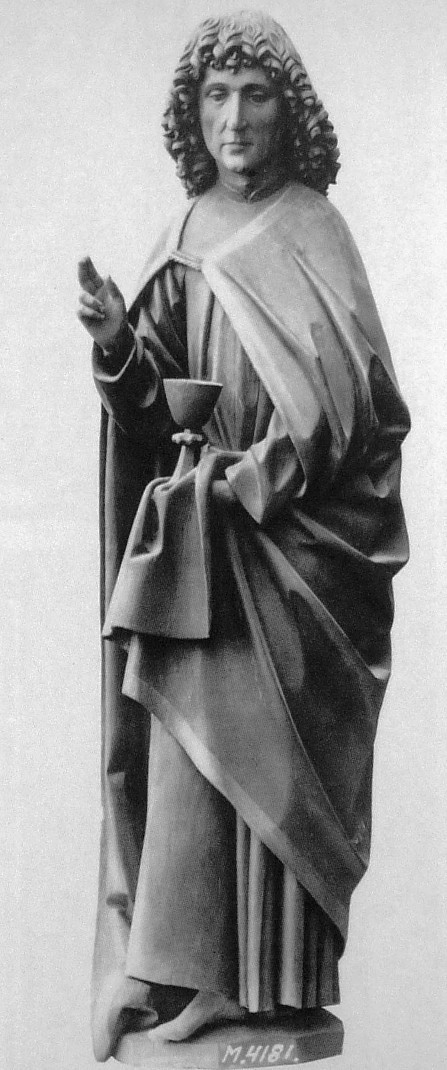
37. St. Matthew. St. Mary. and St. John
(Klosterkirche. Blutenburg.)
The time when these
highly individual figures were created was also especially great in
wood-carving, with which they decorated the Choristers' seats in
their churches. We will give two examples from the Frauenkirche in
Munich, end of the 15th century.

40. Frauenkirche. Munich (The Choir, detail.)

41. Frauenkirche. Munich. (The Choir, detail.)
We now come to the
sculptor who worked at the end of the 15th century.
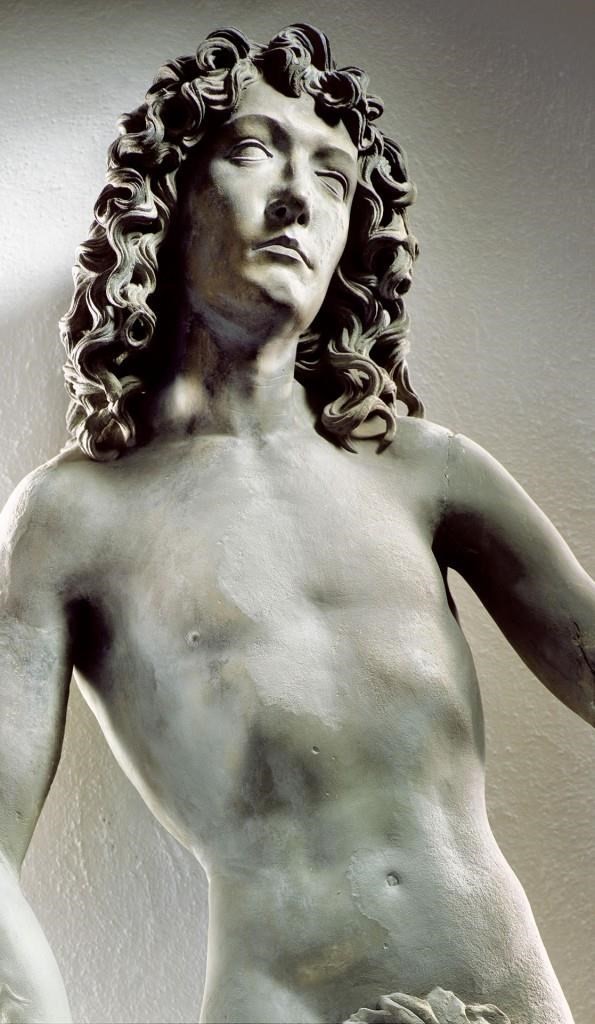
42. Tilman Riemenschneider. Adam. (Wurzburg.)
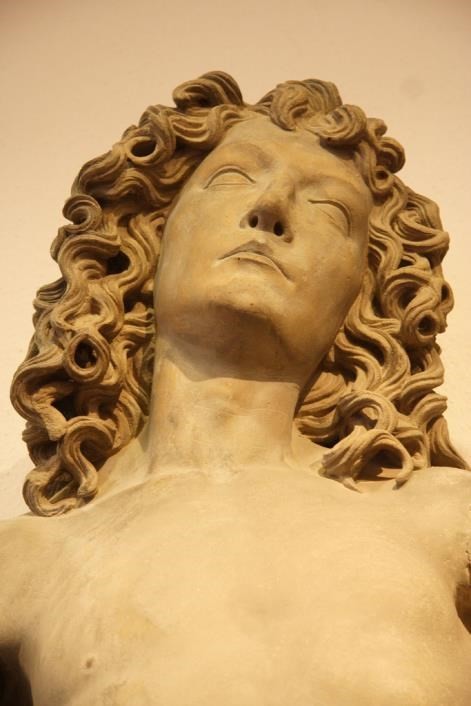
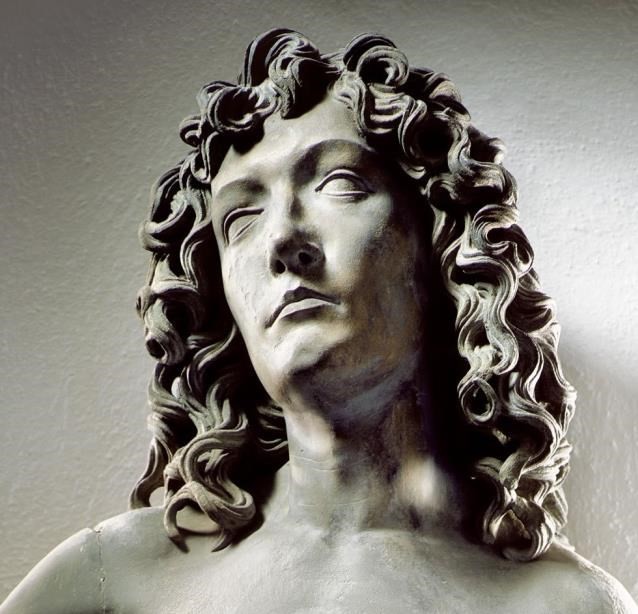
43. Head of Adam. (Detail of above. Wurzburg.)
And this was the time
when the High Renaissance in Italy had not as yet begun. These
works were created about 1490–1495.

44. Eve. Til Riemenschneider. (Wurzburg.)
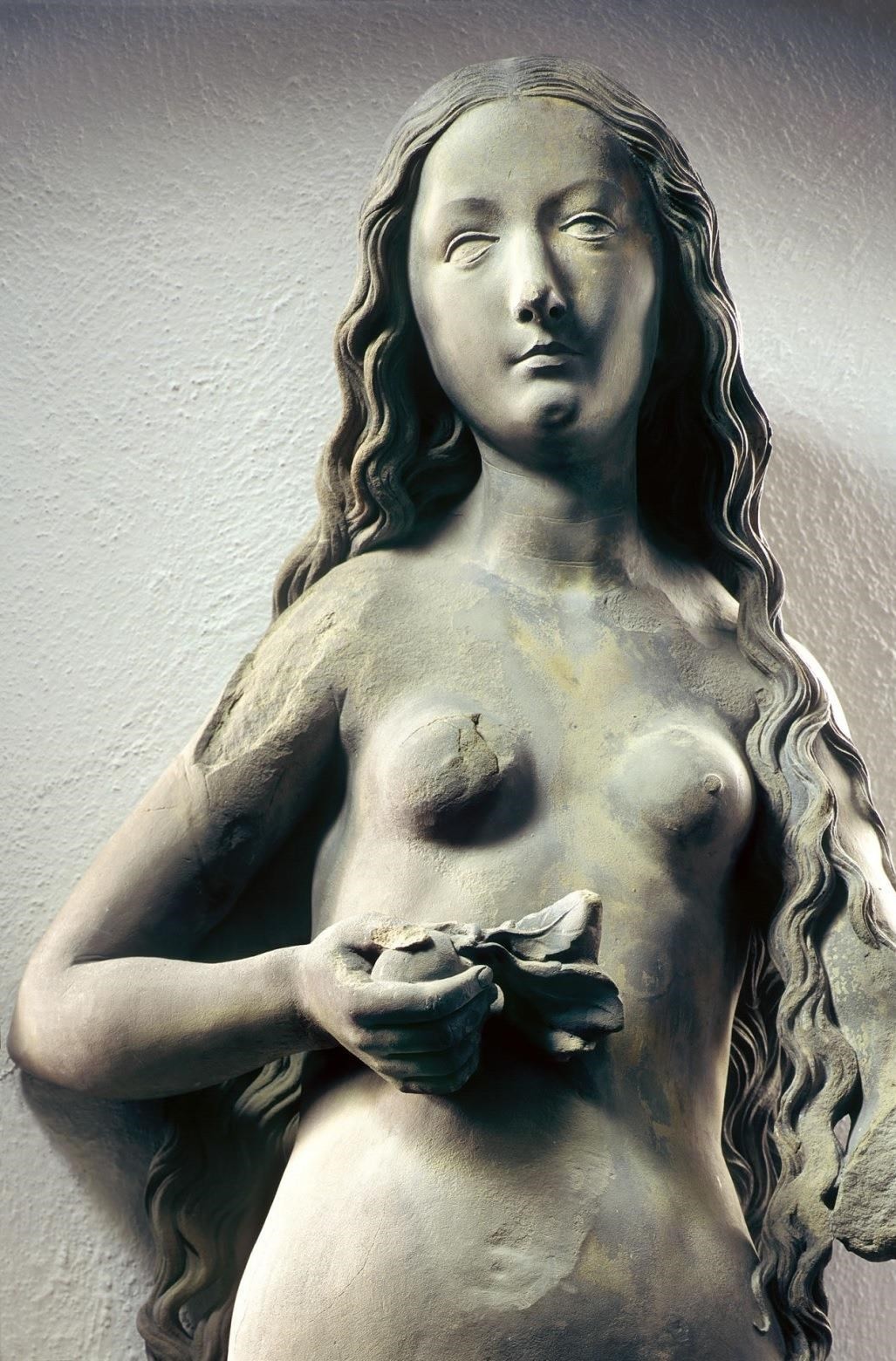
45. Head of Eve. Til Riemenschneider. (Detail of
above.)
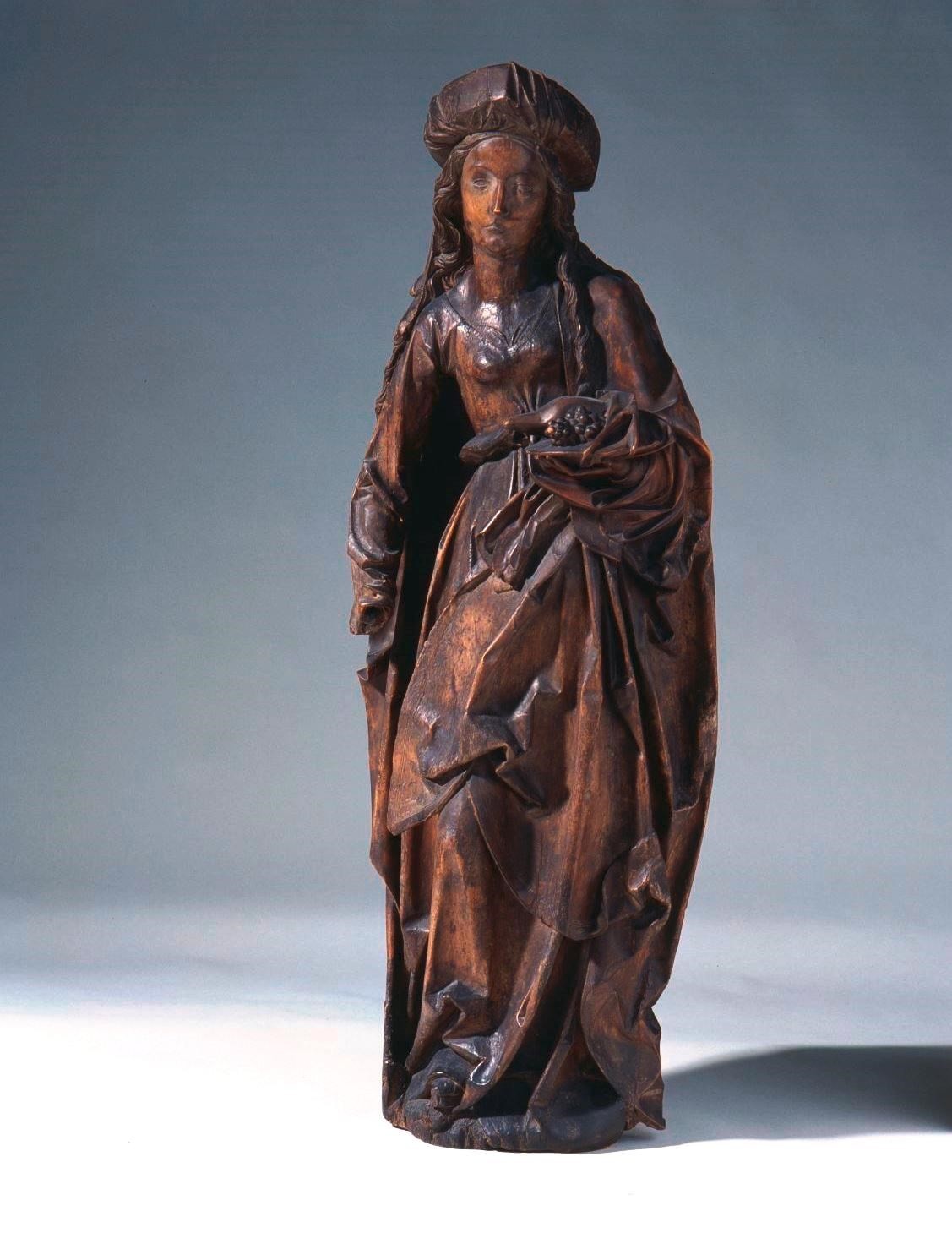
46. Til Riemenschneider. St. Elizabeth.
(Nuremberg.)
This St. Elizabeth
— created in the early 16th century — is now in the
(Germanisches Museum, at Nuremberg.)

47. Til Riemenschneider. Madonna and Child.
(Frankfort.)
This, too, dates from
the beginning of the 16th century.




48. Til Riemenschneider. The Twelve Apostles.
(Frankfort.)
There are wonderful
types among these twelve Apostles; one would like to study every
single head alone:

Peter
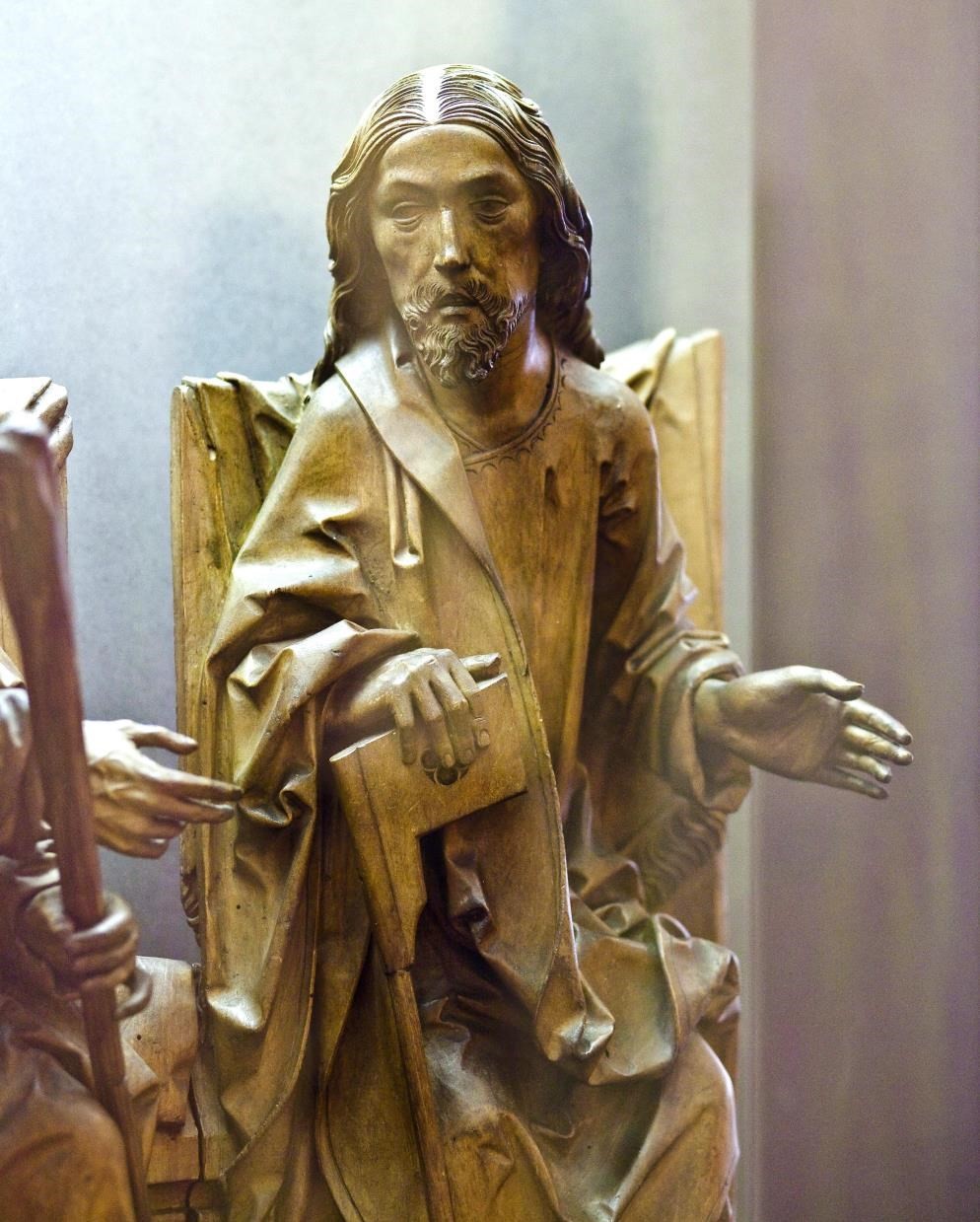
James the Younger
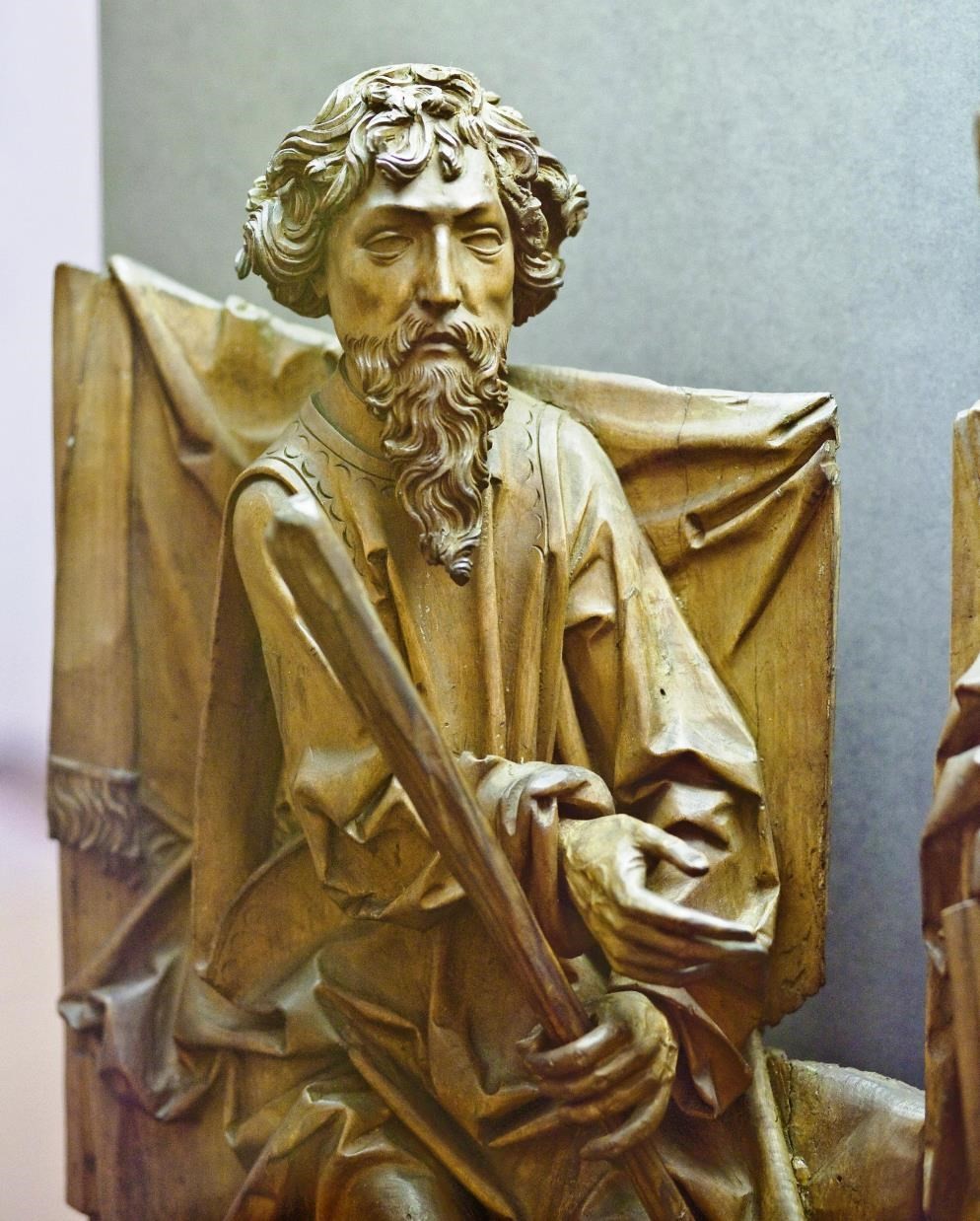
Thaddeus
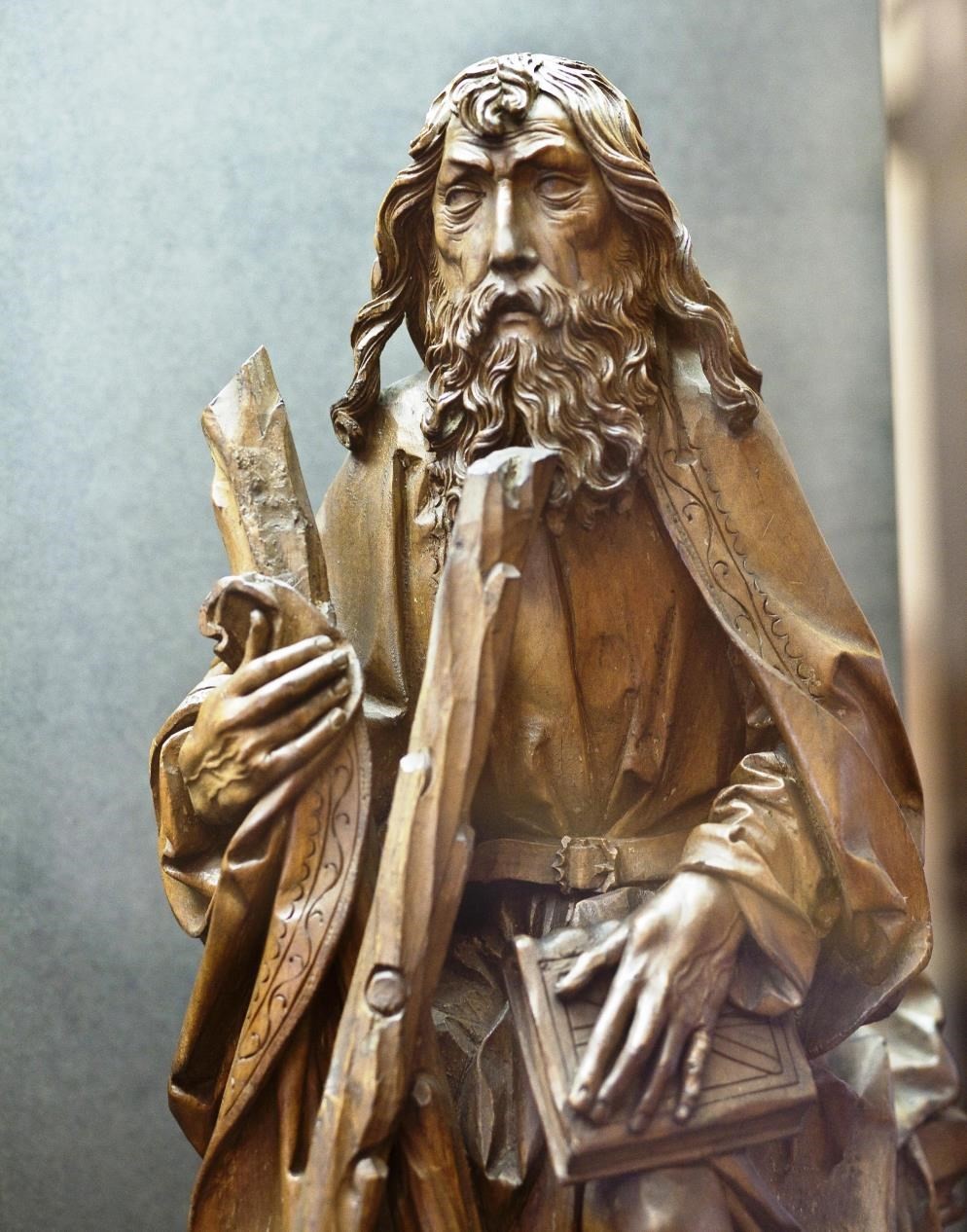
Andrew

Philip

Bartholomew
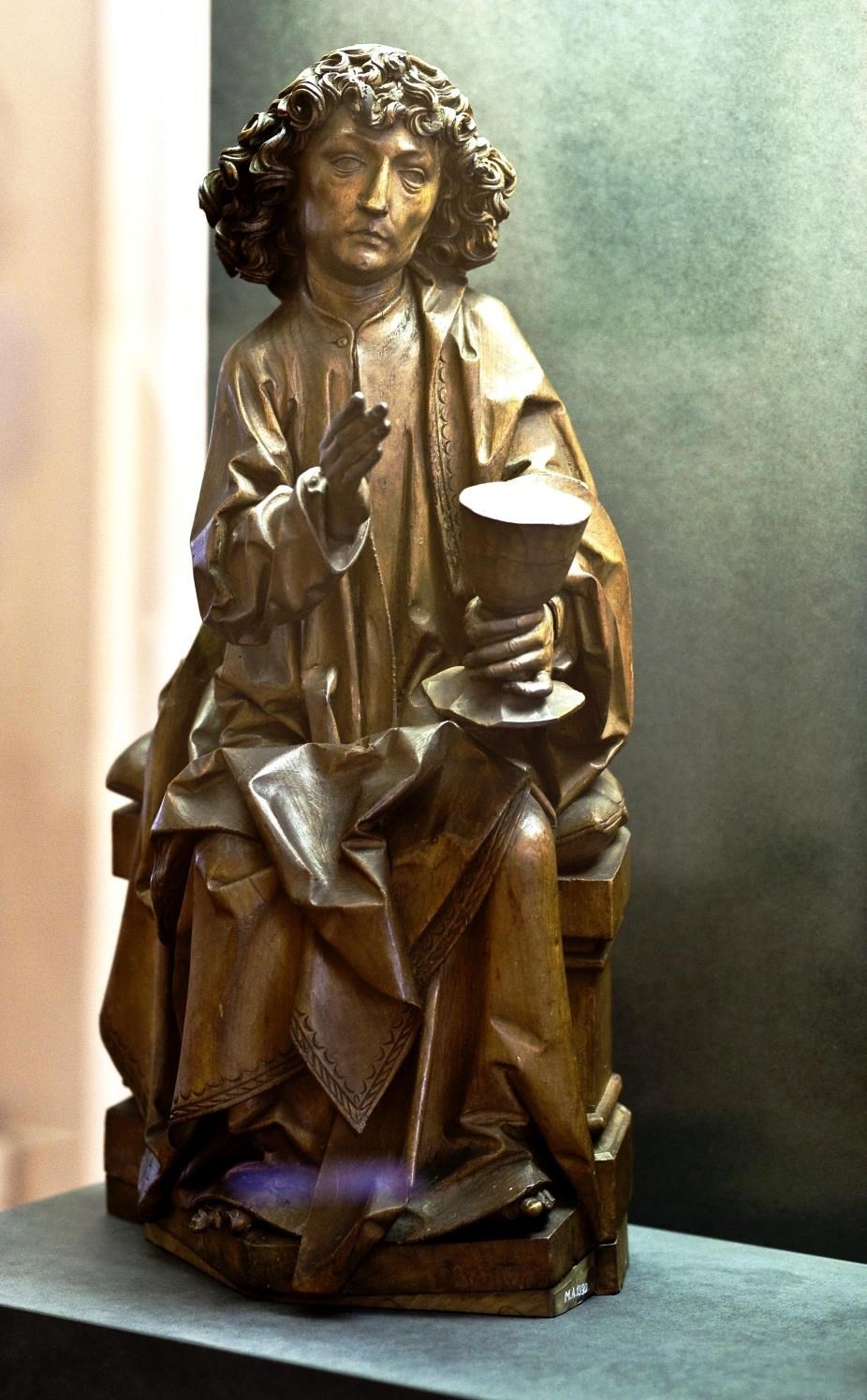
John

James the Elder

Matthias

Simon

Matthew

Thomas
Finally, we give two
examples of the sculptor — Veit Stoss — early 16th
century, who worked in Cracow and also in Southern Germany,
creating his plastic works in many different materials.
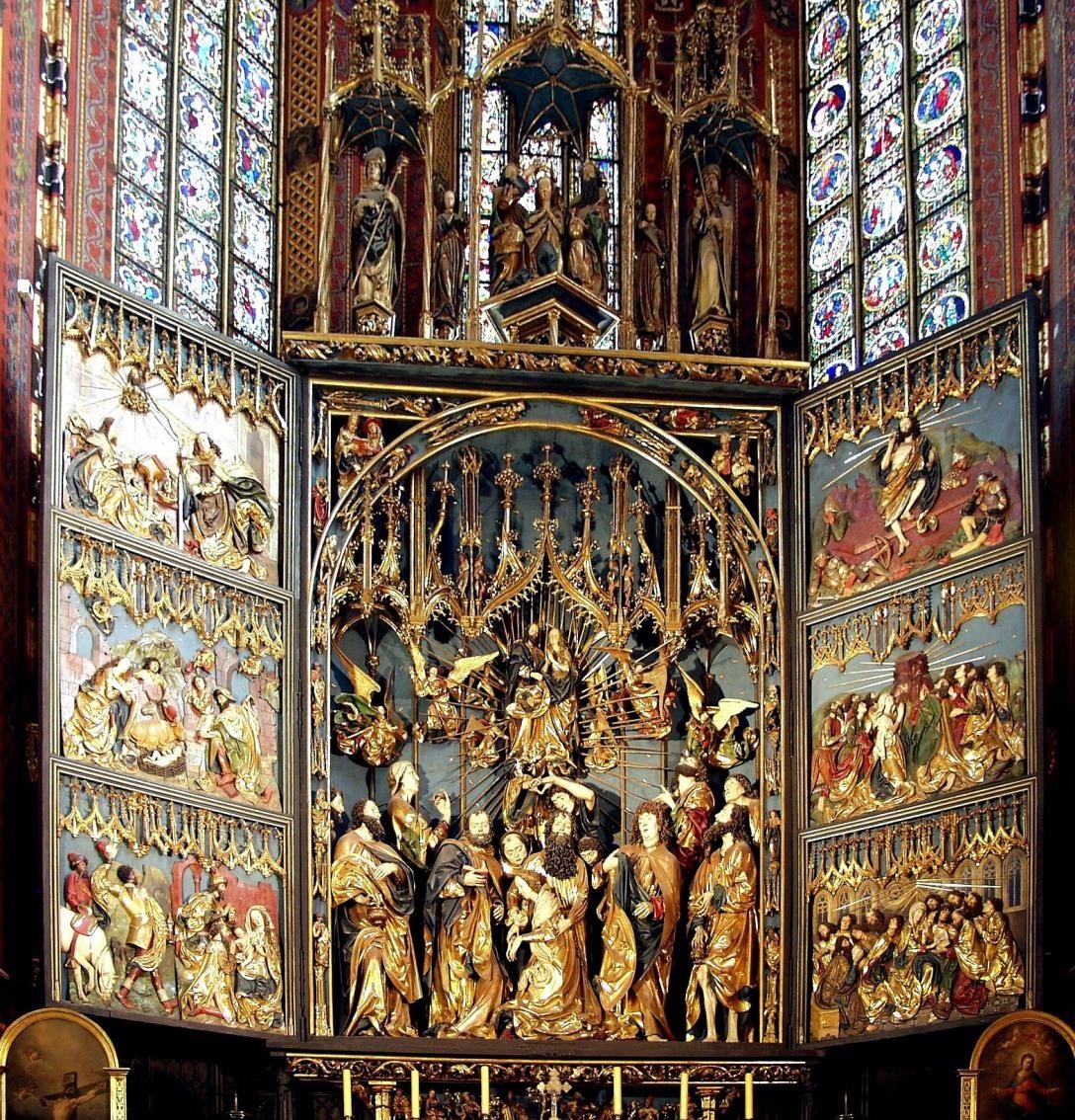


49. Veit Stoss. Marienaltar. (Cracow.)
The next picture is
in Nuremberg,. “The Angel's Greeting,” it is
called.


50. Veit Stoss. ‘Ingelischen Gruss.’
(Nuremberg.)
I will also show
three paintings by Hans Baldung, also known as Hans Grun,
who worked in Dürer's workshop at the beginning of the 16th
century — about 1507–1509.

51. Hans Baldung. The Flight into Egypt.
(Germanisches Museum. Nuremberg.)
His pictures reveal
once more, in the sphere of painting, how everything is turned
towards the life of the soul.

52. Hans Baldung. Crucifixion. (Berlin Gallery.)
Hans Baldung was also
a portrait painter of no mean order. Here you have an example.
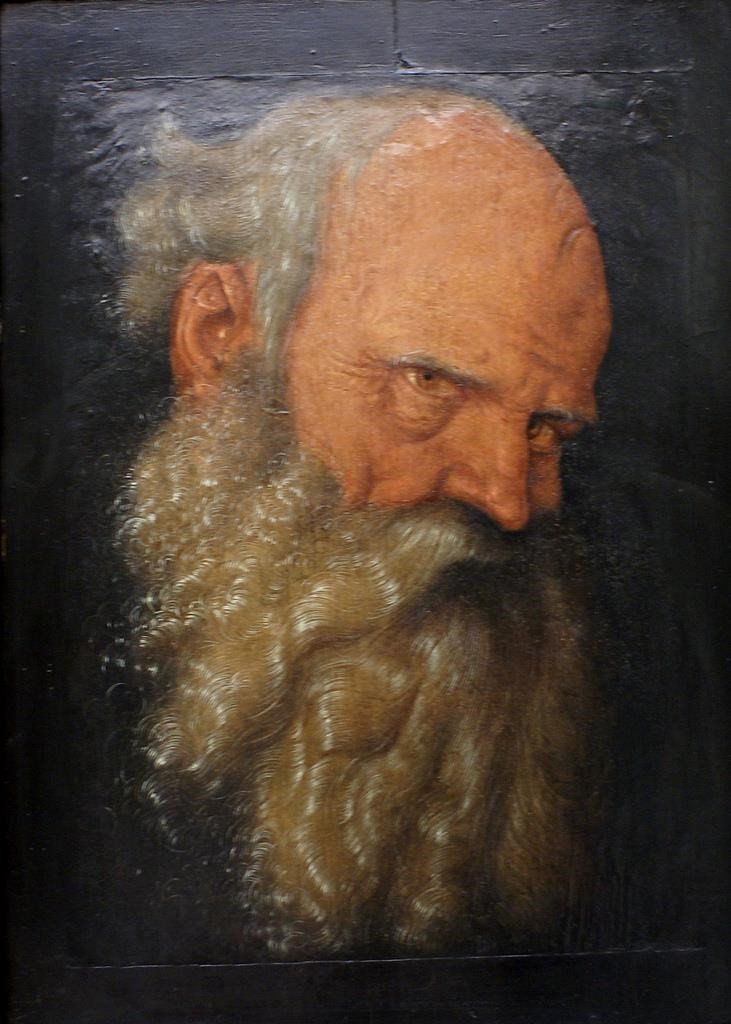
53. Hans Baldung. Head of an Old Man. (Berlin
Museum.)
Here you see how the
same master cultivated the art of portraiture. He was a pupil of
Dürer's, who subsequently lived at Strasburg, and at Freiburg
in Breisgau. He did some wonderful paintings of the Life of Christ,
and of the Mother of Christ. You will find a picture by him at
Basel — “Christ on the Cross.”

This picture, then, is of the early 16th century
— the time of Raphael and Michelangelo in Rome.
My dear Friends, the
more we multiply these pictures, the more should we see, from this
juxtaposition of the Northern and Southern Art, what an immense
revolution took place at the turn of the fourth and fifth
Post-Atlantean Epochs. And the more should we realise how
infinitely rich in content is the simple statement that at that
historic moment Civilisation passed from the development of the
Intellectual, or Feeling Soul into that of the Spiritual Soul.
Infinitely much is contained in such a simple statement. But we
only learn to understand these things of Spiritual Science rightly
when we follow them into the several and detailed domains of human
life.
In conclusion, my
dear Friends, I still wish to speak a word of solemn remembrance to
you on this day. The day after tomorrow is the anniversary of the
death of our dear friend, Fraulein Stinde, and in our hearts we
will not forget to think on that day of all that came into our
Movement through the work of this dear and valued member.
And we will also turn
our thoughts to her soul as she works on in the Spiritual Worlds
— deeply and lovingly connected as she is with our Movement.
On this day especially we will deepen the thoughts and feelings of
our hearts which are directed to her.
I only wished to add
this word of remembrance to remind you of the day after tomorrow.
In memory of all that
unites us with our dear friend — with the soul of our dear
Sophie Stinde — let us now rise from our seats.
|